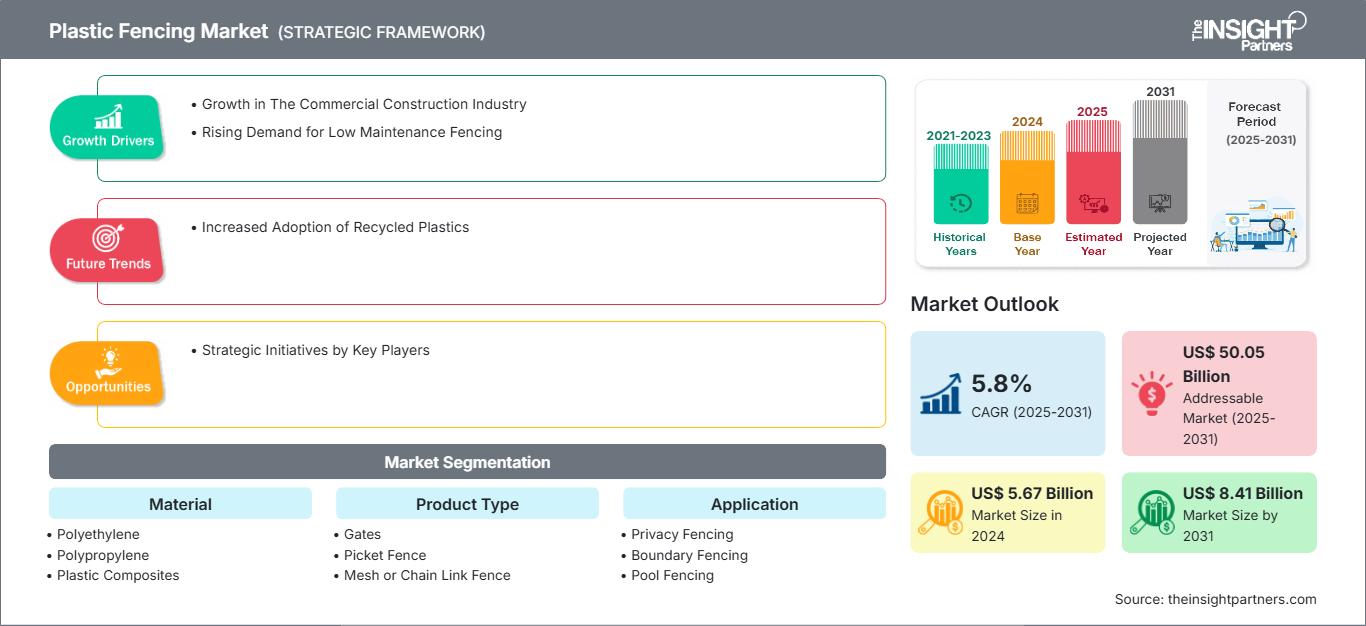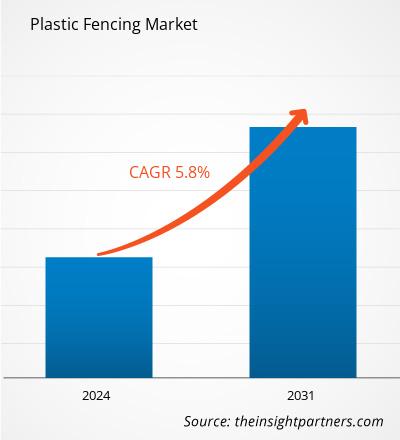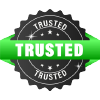The plastic fencing market size is projected to reach US$ 8.41 billion by 2031 from US$ 5.67 billion in 2024; it is expected to register a CAGR of 5.8% during 2025–2031. Technological advancements in feed production are expected to bring in new trends in the market.
Plastic Fencing Market Analysis
In 2024, North America held the largest share of the global plastic fencing market, and Asia Pacific is likely to register the highest CAGR during the forecast period. In Asia Pacific, the demand for plastic fencing is driven by several factors, including rising construction activities and rapid urbanization. In addition, governments of various countries in the region focus on boosting their economy with infrastructure developments and construction projects.
Plastic Fencing Market Overview
The plastic fencing market has witnessed steady growth, driven by increasing demand for durable, low-maintenance, and cost-effective fencing solutions. Plastic fencing, including vinyl and composite variants, has become a preferred choice for commercial properties such as office complexes, retail centers, educational institutions, and industrial facilities due to its superior weather resistance, non-corrosive properties, and longevity. Unlike traditional materials like wood or metal, plastic fences require minimal upkeep, making them particularly attractive for large-scale commercial projects where maintenance costs are a concern.
Additionally, advancements in manufacturing technologies have enabled the production of aesthetically appealing designs, such as textured and color-matched panels, which cater to the visual requirements of commercial spaces. Furthermore, sustainability trends have bolstered the adoption of recyclable plastic fencing options, aligning with corporate initiatives to reduce environmental impact. As urbanization and infrastructure projects continue to expand, the plastic fencing market for various applications is expected to witness robust growth in the coming years. Barrette Outdoor Living Inc, Superior Outdoor Products Inc, Master-Halco Inc, Cornerstone Building Brands Inc, Duramax, USA Vinyl LLC, US Netting Inc, Digger Specialties Inc, Homeland Vinyl Products Inc, Amendola's Fence Co are among the key players operating in the global plastic fencing market.
Customize This Report To Suit Your Requirement
You will get customization on any report - free of charge - including parts of this report, or country-level analysis, Excel Data pack, as well as avail great offers and discounts for start-ups & universities
Plastic Fencing Market: Strategic Insights

-
Get Top Key Market Trends of this report.This FREE sample will include data analysis, ranging from market trends to estimates and forecasts.
Plastic Fencing Market Drivers and Opportunities
Rising Demand for Low-Maintenance Fencing
The rising demand for low-maintenance plastic fencing solutions drives the plastic fencing market. With an increasing emphasis on convenience, durability, and sustainability, contractors are gravitating toward plastic fencing materials that offer long-term benefits with minimal upkeep. High demand for plastic fencing across commercial spaces has made low-maintenance plastic fencing options incredibly appealing, as plastic fences eliminate the need for frequent staining, sealing, and painting typically associated with traditional wood plastic fencing. Additionally, the desire for outdoor spaces that retain their aesthetics and structural integrity over time has led contractors to seek out durable alternatives such as composite and PVC plastic fencing, which are resistant to rotting, warping, and insect damage. As per the Kirkwood Fence, low-maintenance fencing materials, such as vinyl and composite, are expected to witness increased application in the coming years. These materials resist weathering, pests, and decay, ensuring that the fence appears aesthetic with minimal upkeep.
On January 14, 2025, Oldcastle APG announced the launch of its brand—Catalyst Fence Solutions—across North America and Europe. Catalyst Fence Solutions enables personalized fencing solutions, offering a diverse range of commercial fence products. Furthermore, the rising awareness of environmental concerns has propelled the adoption of low-maintenance plastic fencing materials made from recycled plastics, aligning with eco-conscious consumer values. Regular cleaning is necessary to maintain the surface’s quality and appearance. Additionally, manufacturers are innovating and expanding their product lines to meet this surging demand, offering an array of low-maintenance plastic fencing options in various textures, colors, and finishes to cater to diverse aesthetic preferences. This trend has transformed the plastic fencing industry as well as stimulated competition among manufacturers, leading to technological advancements and product development.
Strategic Initiatives by Key Players
The implementation of strategic initiatives by key players is expected to create lucrative opportunities for the plastic fencing market during the forecast period. Plastic fencing manufacturers implement various strategic initiatives, such as research, innovations, and mergers, to maintain competitiveness, meet evolving customer demands, and capitalize on market opportunities. For instance, in 2023, Master Halco expanded its distribution with Envision Outdoor Living Products. The company offers all its lines, including decking, railings, and composite decking, through two additional locations in Southern California. Additionally, in September 2023, Oscillot announced the launch of a cat-proof fence system crafted from premium plastic materials without the use of netting or wires for homeowners to ensure the safety of their cats without compromising the visual appeal of their backyards. Plastic fencing producers invest in research and development to innovate and introduce new products with enhanced properties, functionalities, and sustainable features. The product launches by key market players also include the development of formulations with improved color accuracy, dispersion properties, and specialty additives for specific applications.
As consumer preferences evolve, there is a heightened demand for plastic fencing solutions that offer superior performance, durability, sustainability, and aesthetic appeal. This demand has spurred innovation within the plastic fencing for commercial application market, with manufacturers continually developing new materials, technologies, and designs to meet the evolving needs of consumers. One of the key areas of innovation lies in the development of composite plastic fencing materials, which offer a compelling alternative to traditional wood plastic fencing. For instance, in November 2023, Birkdale introduced three composite fence panels under its DuraPost range: Prima, Urban Slatted, and Vento available in a range of color options.
Plastic Fencing Market Report Segmentation Analysis
Key segments that contributed to the derivation of the plastic fencing market are material, product type, application, and end use.
- Based on material, the market is segmented into polyethylene, polypropylene, plastic composites, vinyl, polystyrene, and others. The vinyl segment held the largest share of the plastic fencing market in 2024.
- By product type, the market is segmented into gates, picket fence, mesh or chain link fence, post and rail fencing, palisade fencing, and others. The mesh or chain link fence segment held the largest share of the plastic fencing market in 2024.
- In terms of application, the market is segmented into privacy fencing, boundary fencing, pool fencing, temporary fencing, and others. The privacy fencing segment dominated the plastic fencing market in 2024.
- Based on end use, the market is segmented into residential, commercial, institutional, and others. The residential segment held the largest share of the plastic fencing market in 2024.
Plastic Fencing Market Share Analysis by Geography
The geographical scope of the plastic fencing market report is mainly divided into five regions: North America, Asia Pacific, Europe, Middle East and Africa, and South & Central America.
Asia Pacific is expected to record the highest CAGR over the forecast period. The construction industry in Asia Pacific is witnessing rapid growth attributed to favorable government initiatives and rapid urbanization. China is the largest contributor to the construction industry growth in the region. In addition, governments of various countries in the region focus on boosting their economy with infrastructure developments and construction projects. For instance, according to the South East Asia Iron and Steel Institute, the construction sector in Indonesia grew by 4.9% in 2023 due to increased development activities and government capital expenditure in the country. Also, Asia Pacific witnessed increased residential construction projects in emerging countries. For instance, Singapore's Housing & Development Board announced plans to launch 23,000 build-to-order flats in mature estates to meet the growing demand for residential units. Thus, the increased demand for residential and commercial construction projects and infrastructure development contributes to the market for plastic fencing in Asia Pacific.
Plastic Fencing Market Regional InsightsThe regional trends and factors influencing the Plastic Fencing Market throughout the forecast period have been thoroughly explained by the analysts at The Insight Partners. This section also discusses Plastic Fencing Market segments and geography across North America, Europe, Asia Pacific, Middle East and Africa, and South and Central America.
Plastic Fencing Market Report Scope
| Report Attribute | Details |
|---|---|
| Market size in 2024 | US$ 5.67 Billion |
| Market Size by 2031 | US$ 8.41 Billion |
| Global CAGR (2025 - 2031) | 5.8% |
| Historical Data | 2021-2023 |
| Forecast period | 2025-2031 |
| Segments Covered |
By Material
|
| Regions and Countries Covered |
North America
|
| Market leaders and key company profiles |
|
Plastic Fencing Market Players Density: Understanding Its Impact on Business Dynamics
The Plastic Fencing Market is growing rapidly, driven by increasing end-user demand due to factors such as evolving consumer preferences, technological advancements, and greater awareness of the product's benefits. As demand rises, businesses are expanding their offerings, innovating to meet consumer needs, and capitalizing on emerging trends, which further fuels market growth.

- Get the Plastic Fencing Market top key players overview
Plastic Fencing Market News and Recent Developments
The plastic fencing market growth is evaluated by gathering qualitative and quantitative data post-post-primary and secondary research, which includes important corporate publications, association data, and databases. A few of the developments in the plastic fencing market are listed below:
- Superior Outdoor Products introduced the 100 Series vinyl railing, designed for volume builders with a sleek aesthetic and quick installation. (Superior Outdoor Products, Company Website, February, 2024)
- Master Halco expanded its distribution with Envision Outdoor Living Products. The company offers all its lines, including decking, railings, and composite decking, through two additional locations in Southern California. (Master Halco, Company Website, April, 2023)
Plastic Fencing Market Report Coverage and Deliverables
The " Plastic Fencing Market Size and Forecast (2021–2031)" report provides a detailed analysis of the market covering below areas:
- Plastic fencing market size and forecast for all the key market segments covered under the scope
- Plastic fencing market trends, as well as market dynamics such as drivers, restraints, and key opportunities
- Detailed Porter's Five Forces and SWOT analysis
- Plastic fencing market analysis covering key trends in the market, country framework, major players, regulations, and recent market developments.
- Industry landscape and competition analysis covering market concentration, heat map analysis, prominent players, and recent developments in the plastic fencing market
- Detailed company profiles
Frequently Asked Questions
What are the factors driving the plastic fencing market?
What are the future trends in the plastic fencing market?
Which are the leading players operating in the plastic fencing market?
What is the expected CAGR of the plastic fencing market?
Which region held the largest share of the global plastic fencing market?
Based on end use, which segment held the largest share in the global plastic fencing market?
- Historical Analysis (2 Years), Base Year, Forecast (7 Years) with CAGR
- PEST and SWOT Analysis
- Market Size Value / Volume - Global, Regional, Country
- Industry and Competitive Landscape
- Excel Dataset
Recent Reports
Related Reports
Testimonials
Reason to Buy
- Informed Decision-Making
- Understanding Market Dynamics
- Competitive Analysis
- Identifying Emerging Markets
- Customer Insights
- Market Forecasts
- Risk Mitigation
- Boosting Operational Efficiency
- Strategic Planning
- Investment Justification
- Tracking Industry Innovations
- Aligning with Regulatory Trends





















 Get Free Sample For
Get Free Sample For